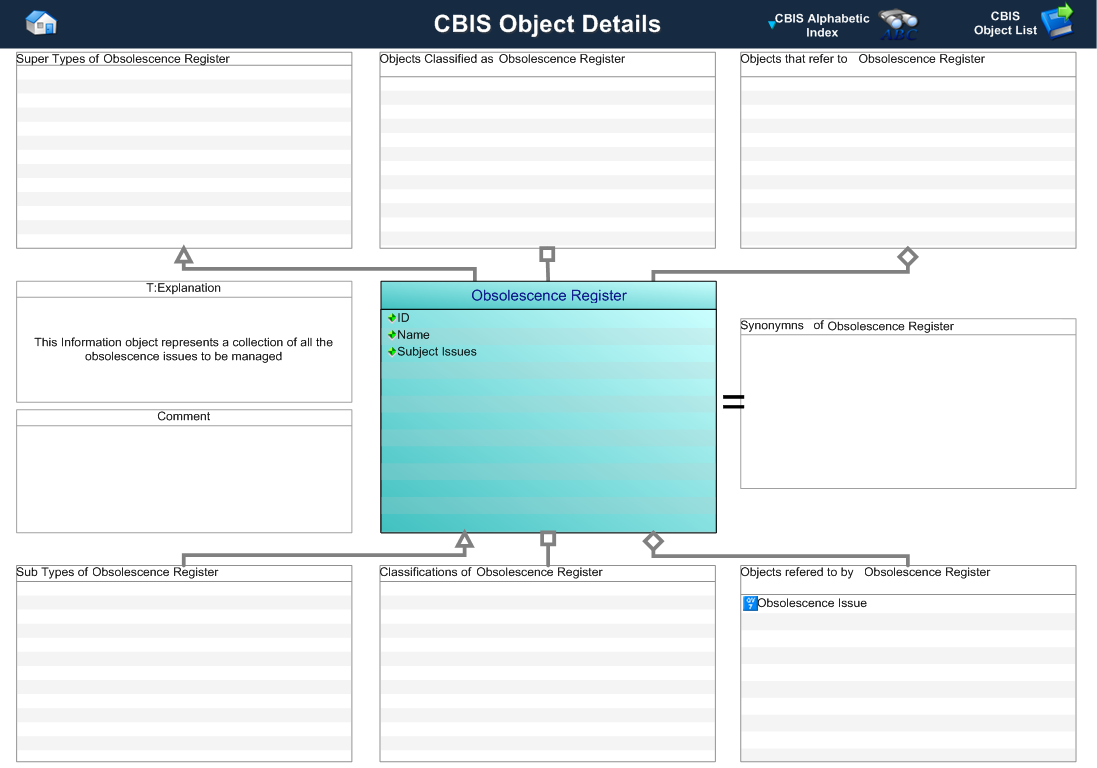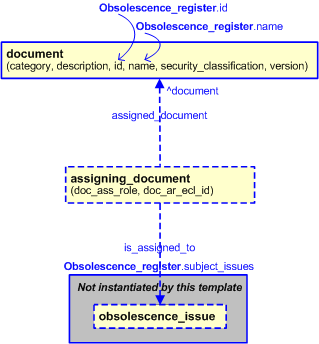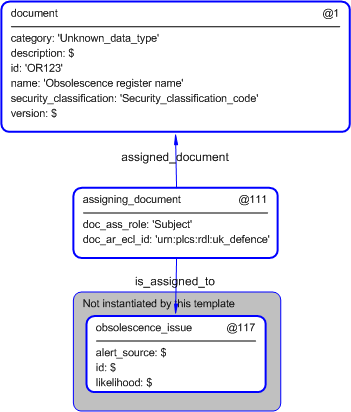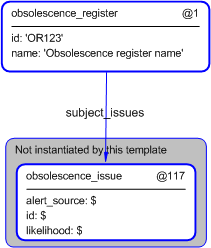Template:— obsolescence_register (obslscnce_regstr)
Context:— UK_Defence |
Date: 2010/03/15 14:46:04
Revision: 1.5
|
This section specifies the template obsolescence_register.
NOTE
The template has been defined in the context of
UK_Defence.
Refer to the business context for details of related templates.
NOTE
An explanation of a template and the associated instantiation path is
provided in the
Template overview
section.
This template describes how to represent the concept of an obsolescence_register in terms of PLCS model elements (templates,
entities, and reference data).
A fleet is a named collection of products that are managed as a whole to meet an operational requirement.
This information object represents a named collection of products that are managed as a whole to meet an operational
requirement.
Figure 1 — A MOOD Business Architect representation of the Business Object: Obsolescence Register
The attributes of the Obsolescence Register object are tabled below.
|
Attribute name
|
Attribute description
|
Attribute type
|
Optionality
|
| ID |
This is the identifier of the obsolescence register. |
intrinsic |
Mandatory |
| Identifier.id |
This is the value of the id attribute of the Identifier applied to the obsolescence register. |
intrinsic |
Mandatory |
| Name |
This is the name of the obsolescence register. |
intrinsic |
Mandatory |
| Subject Issues |
This is a reference to the obsolence issues held in the register. |
Relationship to Obsolescence Issue |
Optional |
Table 1 — Obsolescence Register attribute details
The EXPRESS-G diagram in
Figure
2
shows the templates and EXPRESS entities that are required
to represent the template
"obsolescence_register".
The text highlighted in blue shows the template parameters.
Figure 2 — An EXPRESS-G representation of the Information model for obsolescence_register
The graphic for the template to be used in other EXPRESS-G diagrams
is shown in Figure
3
below.
Figure 3 — The graphical representation of the obsolescence_register template
The following input parameters are defined for this template:
The identifier of the obsolescence register.
The name of the obsolescence register.
The reference to the obsolescence issue.
The following reference parameters are defined for this template:
Allow the
Document
entity instantiated in this path to be referenced when this template is used.
Note: The
Document
entity can be referenced in a template path by:
%^target = $obsolescence_register.document%
where
target
is the parameter to which the
Document
is bound.
Allow the
Document_version
entity instantiated in this path to be referenced when this template is used.
%^target = $obsolescence_register.document_version%
Allow the
Document_definition
entity instantiated in this path to be referenced when this template is used.
%^target = $obsolescence_register.document_definition%
The instantiation path shown below specifies the entities that are to be
instantiated by the template.
A description of templates and the syntax for the instantiation path is
provided in the
Templates Help/Information section.
-- ID -- name /
document(
author='',
category='Unknown_data_type',
description='',
id=@id,
name=@name,
releasing_authority='',
security_classification='',
valid_from_date=$,
valid_to_date=$,
version='')/
%^document = $document.document%
%^document_version = $document.document_version%
%^document_definition = $document.document_definition%
-- subject_issues /
assigning_document(
doc_ass_role='Subject',
doc_ar_ecl_id='urn:plcs:rdl:uk_defence',
assigned_document=^document,
is_assigned_to=@subject_issues)/
The instance diagram in Figure
4
shows an example of the EXPRESS entities and templates that are instantiated by the template:
/obsolescence_register(id='OR123', name='Obsolescence register name', subject='@314')/
(an illustration of the consolidated obsolescence_register template is shown in
Figure
5 below.)
Figure 4 — Entities instantiated by obsolescence_register template
The instance diagram in
Figure
5
shows the graphic symbol for the template that is to be
used in other instance diagrams. The example template is:
/obsolescence_register(id='OR123', name='Obsolescence register name', subject='@314')/
Figure 5 — Instantiation of obsolescence_register template
Characterizations
No common characterizations of the template
obsolescence_register
have been identified. However, the ISO 10303-239 EXPRESS model
may enable other assignments to the entities instantiated by the template.




